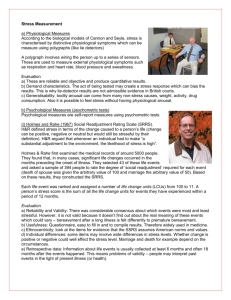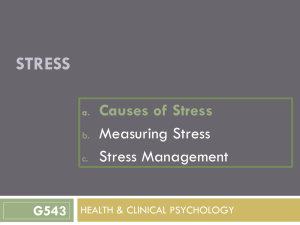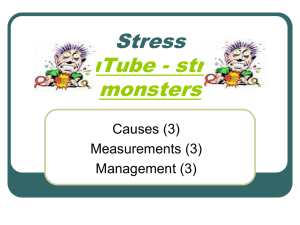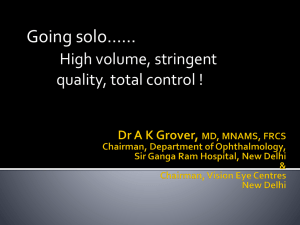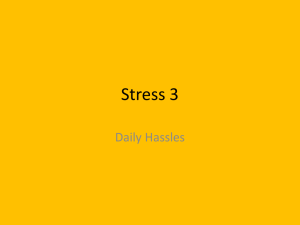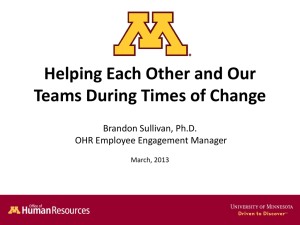Causes of Stress
advertisement
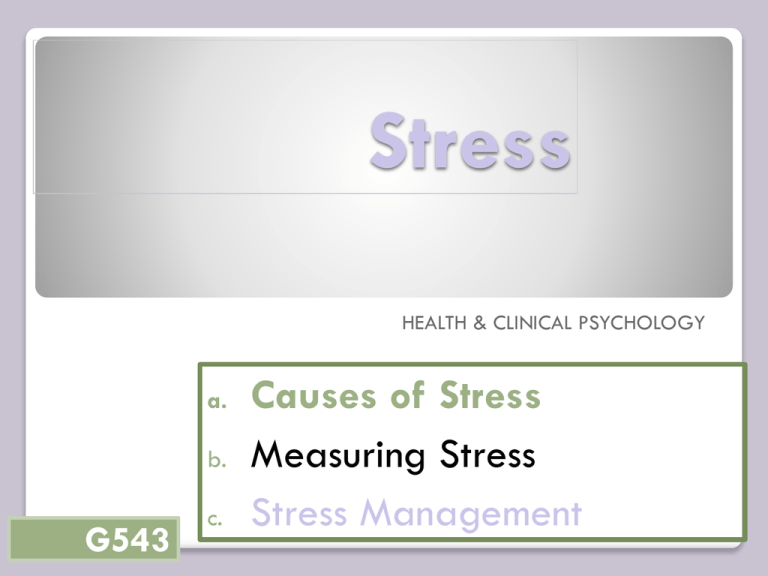
Stress HEALTH & CLINICAL PSYCHOLOGY a. b. G543 c. Causes of Stress Measuring Stress Stress Management What is stress? What causes stress? While the class settles down, think of as many causes of stress as you can. Ext: Are there different types of stress? What makes them different? Clearly there are many types of stress and how we experience stress will vary from person to person. It is, however, useful to have a general understanding of what we mean when we refer to ‘stress’, psychologically speaking DEFINING STRESS Stress is a state of physiological or psychological strain caused by unpleasant stimulus. Stress can be defined as being; a pattern of negative physiological states and psychological responses occurring in situations where people perceive threats to their well being which they may be unable to meet. Stress has 3 main elements; the stressor or stimulus, the perception the person feels that they are under threat and the DEFINING STRESS Cognitive Responses: Confused thought Emotions – anxiety, worry, depression Learned helplessness – little mental activity Behavioural Responses: Poor co-ordination – fumbling, trembling Fidgeting Aggression Slow movements, lacking motivation Can be measured through observation or selfreport methods Psychological Response to Stress a. b. c. Workplace: Johansson Hassles: Kanner The Role of Control: Geer & Meisel 1. Causes of Stress WORKPLACE January 2010 Describe one piece of research which considers workplace stress. (10) Discuss problems of conducting research into the causes of stress. (15) June 2014 Outline how work can be a cause of stress. (10) Evaluate the use of quantitative data when researching the causes of stress. (15) DAILY HASSLES June 2011 Outline one piece of evidence which suggests that stress can be caused by hassles and or life events. (10) Evaluate the reliability of methods of measuring stress. (15) ROLE OF CONTROL Example Outline one piece of evidence which suggests that stress can be caused by lack of control. (10) Evaluate the use of qualitative data when researching the causes of stress. (15) a. b. c. Workplace: Johansson Hassles: Kanner The Role of Control: Geer & Maisel Stress is a biological response to an external stimulus. The biological response is the fight or flight mechanism where stress causes an increase in blood pressure, a reduction in blood flow to the extremities and an increase in adrenaline. Background: Activity On your worksheet, highlight the sources of workplace stress in each scenario Work in 2s or 3s Workplace scenarios You have an overview in your textbook so annotate that or the slides as we go through them. WORKPLACE STRESSORS: JOHANSSON Aim To measure the amount of stress experienced by sawmill workers and to look for a causal relationships on work satisfaction and production. Background Modern production methods require constant attention to detail on monotonous repetitive production lines which have increased efficiency by requiring workers to specialise in particular tasks. However, this has led to low self-esteem and a lack of work satisfaction in the workforce, increasing stress-related illness. Sample • Swedish mill workers • 14 high-risk workers, who cut, edged and graded wood – isolated and highly skilled 2a. Summary Information: WORKPLACE • Control group of 10 repair and maintenance workers – more freedom to set the pace of their own work/socialise JOHANSSON, 1978 • The mean age of both groups was 38.4. • All were shift workers paid by piece rate based on group performance. WORKPLACE STRESSORS: JOHANSSON Method Procedure This was a quasi-experiment where the workers fell naturally into the two groups. • Levels of stress-related hormones were measured using urine samples on work and rest days. • Self-report questionnaires were also given to assess mood, alertness and caffeine and nicotine consumption. • Body temperature was measured at the time of the urine sample. • Self-rating scales were given, rating words such as ‘well-being’, ‘sleepiness’ and ‘irritation’. • Records were kept of stress-related illnesses and absenteeism. These were compared to a day spent at home where workers were asked to stay up as if they were at work. Results Conclusions Excretion of adrenaline in the urine of the high-risk workers was twice as high as the baseline and continued to increase to the end of the day, while the control group peaked in the morning then declined for the rest of the day. Self-reports showed the high-risk group feeling more rushed and irritated than the control group. More positive mood was reported by those doing non-repetitive tasks. A combination of work stressors such as machine pacing, repetitiveness and a high level of responsibility, lead to chronic physiological arousal, leading to stress-related illnesses and absenteeism. Reducing work stressors can reduce illness and absenteeism. Reliable? YES NO Valid? Self-report useful? Sample limited? Situational vs dispositional Usefulness Psych as a Science Based on what you have learnt today, how could we improve the experience of workers? In pairs, come up with an idea or concept to improve the workplace. Plenary task a. b. c. Workplace: Johansson Hassles: Kanner The Role of Control: Geer & Maisel Daily hassles and uplifts In pairs, discuss for a couple of minutes what you would include on a ‘hassles’ and ‘uplifts’ scale. Let’s briefly clarify what we mean by this: HASSLES: irritants—things that annoy or bother you; they can make you upset or angry. UPLIFTS: events that make you feel good; they can make you joyful, glad, or satisfied. Some hassles and uplifts occur on a fairly regular basis and others are relatively rare. HASSLES UPLIFTS DAILY HASSLES: KANNER, 1981 Aim Background To compare the Daily Hassles and Uplifts Scale versus the Major Life Events Scale to see if hassles were in fact the greater cause of stress. Kanner believed that it was not just the big events in life, but the many smaller daily events, in life, but the many smaller daily events, such as bad traffic, queuing, being left on hold on a phone that add up to make us stressed. He believed a person can withstand a major event once in a lifetime far more easily than constant smaller ones. He also believed that uplifts such as feeling joy or good news had to be part of the picture. DAILY HASSLES: KANNER, 1981 Sample Opportunity 52 women and 48 men all white, who participated in a 12-month study of stress in Canada. DAILY HASSLES KANNER, 1981 Each person took both the measures of stress above once a month for 9-months. They also completed the Hopkins Symptoms Checklist (of stress symptoms) and the Bradburn Morale Scale of well-being towards the end of the study. Method/ procedure Asked to circle the events on both scales that they had experienced the previous month and rate each according to severity (for the hassles) and frequency (for the uplifts). Each participant was tested once a month for ten consecutive months using the two stress measures together with another two psychometric tests for psychological well-being Top hassles: • Weight • Health • Money Top uplifts: • Good relationships with partner and friends Results • • • • • Participants self-reported hassles were consistent from month to month. For men, life events positively correlated with hassles and negatively with uplifts. For women, life events positive correlated with hassles and uplifts. Hassle frequency positively correlated with psychological symptoms on the HSCL. Hassles proved a stronger predictor of stress than life events Assessment of daily hassles and uplift may be a better approach to the prediction of stress and ill Information: health than the life events approach. 2b. Summary DAILY HASSLES Conclusions KANNER, 1981 Hassles contribute to psychological symptoms, whatever life events happen. Self-report? Sample? Longitudinal/snapshot Ecologically valid? Internally valid? Reliable? Ethics? Determinism and freewill Reductionism/holism Psych as a science Suggests that everyday hassles (possibly beyond our control) determine our stress levels. Takes into account and investigates multiple factors affecting stress levels. Self report not a reliable or scientific measure as may be subject to interpretation. Read the ‘model’ answer and do the following 1. 2. Give it a mark out of 10 Suggest and write up improvements Describe one piece of research which considers workplace stress. (10) EXAM PRACTICE HOMEWORK Outline one piece of evidence which suggests that stress can be caused by hassles and or life events. (10) DUE NEXT LESSON a. b. c. Workplace: Johansson Hassles: Kanner The Role of Control: Geer & Maisel CONTROL: GEER & MAISEL, 1972 Aim Does lower stress result from being able to predict the occurrence of an unpleasant stimuli or is the lower stress related to the controlling behaviour itself? Background People prefer predictable rather than unpredictable averse events. By definition, people who control the termination of a stimulus can also predict its length. Therefore, people who can predict when an unpleasant event is going to stop should have a lower stress response to it. Sample 60 psychology undergraduates from New York University. Here ‘control’ means in control, not a comparison group. CONTROL: GEER & MAISEL, 1972 Method A laboratory experiment involving three groups and using an independent measure design. The ‘control’ group saw ten pictures of victims of violent death at 60second intervals with a warning tone ten seconds before each one. They could press a button to change the picture as they wished. The ‘predictability’ and ‘no control’ group had no button and instead were ‘yoked’ to the control group. Joined to. Procedure The ‘predictability’ group were unable to terminate or control the presentation but they knew about the relationship of the warning tone to the picture so they know when it would come and how long it would last. The ‘no control’ group had no control and no idea how long each picture would last. They thought pictures and tones occurred at random. Data was collected by heart rate monitors and galvanic skin response via a polygraph. GSR results showed a clear difference between the prediction group and the other two, with a much greater stress response to the warning tone. There was not difference in response to the photographs between the predictability and not control groups but the control group itself show a lower skin conductance. Results & Conclusions Therefore, being able to predict what was coming did not seem to prevent the stress response, whereas being able to stop it did. Having control over aversive stimuli reduces its stressful impact. Heart rate monitors malfunctioned and were not included in the analysis. Ethical? Internally valid? Reliable? Sample limited? Ecologically valid? Useful? Psychology as a Science? Reductionist? Homework Complete the evaluation slide below or on the A3 handout Complete an essay plan for the following essay: DUE NEXT LESSON Discuss problems of conducting research into the causes of stress. (15) Introduction P1 P2 (counter-argument) P3 P4 (counter-argument) P5 P6 (counter-argument) Conclusion Can each explanation explain all disorders? To what EXTENT is each explanation useful and appropriate?
